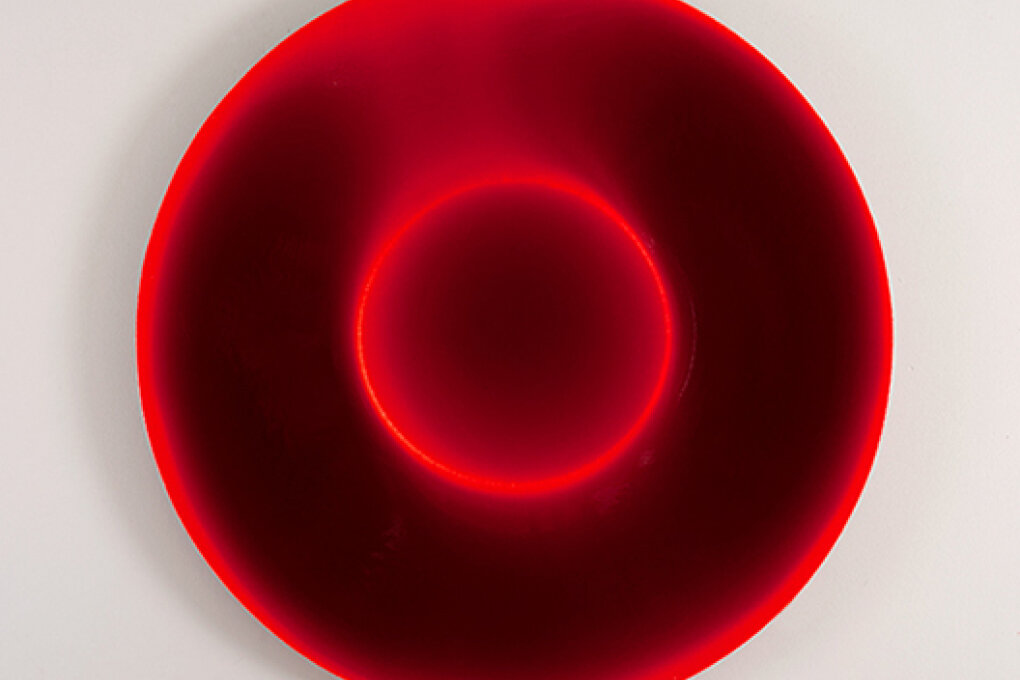Milan Houser
Colourmetry
9. 3. 2016 – 1. 5. 2016
House of Arts
Curator
Vlado Beskid
Graphic Design
Adam Macháček

The paintings of Milan Houser usually display multiple layers – similar to the way his work comprises several levels, enabling it to be grasped from different points of view. One of them consists in thematising the phenomenon of the colour in itself – pigment, the monochrome surface of paint. It allows the viewer to follow the continuity in modern art from Russian suprematism through American colour field painting – from Malevich’s classical concept of the white square on a white ground through black paintings by Ad Reinhardt and, at present, from Morrelet’s white canvases with neons up to the black plaster fields of Allan McCollum (Surrogate Paintings). This line, dominated by Rothko’s dark mystical canvases in Houston (Mark Rothko Chapel) and the unique patented ultramarine IKB by Yves Klein, resonates synchronically with the whole stream of minimalism, monochromatic and geometric abstraction – with works of Blinky Palermo, Günter Umberg, Peter Halley, with shaped canvases and objects of Frank Stella or with “colour stepping out into space” in Imi Knoebel’s varnished boards and large monochrome surfaces of Ettore Spalletti executed directly on walls. Houser’s interest in colour is also reminiscent of the use of pure pigment, as known from the work of Anish Kapoor or Jason Martin. Even the silent falling of red pigment along the walls in Ann Hamilton’s project for the US exhibition at the 48th Venice Biennale (Myein, 1999) does not lack an affinity with the approach of Milan Houser.
For this first individual presentation in Brno, the artist did not opt for a traditional retrospective view, but decided instead to cope and communicate directly with the space of the House of Arts, which offers some of the most impressive exhibition halls in Central Europe. From the beginning, he has worked with a clearly formulated concept based on a transposition of the space into a single pure white cube, which was achieved by interconnecting the three main halls with a strong light modulation and a separation of the two smaller rooms that he has turned into a kind of laboratory space with a saturated atmosphere of expansive colour fields. This has given rise to a DOME full of colour and light – a singular “COLOR HOUSE-R”.
The pivotal work in Houser’s exhibition is an impressive site specific installation titled Barvometrie (Colourmetry) – a huge block of red vertical “threads” leading from the light well down to the floor, a regular grid of thin coloured stalactites, grown thanks to the natural downward flow of the paint and varnish with the uncommon use of gravity as artistic tool. In order to materialize the central part of the installation it was necessary to find and hire a factory hall that allowed – using a movable platform rising to the height of ten meters – to realise the time-consuming process of slowly pouring paint and the gradual accumulation of “dripstones”. The monumental, eight-meter high waterfall of paint was finally completed in three months and compressed into a clear order – a regular rhythm of over 1,800 “colour-stalactites” – it constitutes the central part of the exhibition, like a metaphorical measurement of space with the help of colour, a total occupation of space with painting. At the same time, though, this is a measurement of our cultural sensitivity. What can still stand for a painting? Is it possible to reduce it to a basic gesture? Does painting exist without any relationship to a surface?
This “dialogue of painting with architecture” not only features a strong gesture of liberated painting, a step out into space, but at the same time it confirms Houser’s long-term research in the materiality of painting and his analyses of physical and chemical forces and processes (measuring of space by means of paint; plane – space interface; organic liquidity of the painting matter and the geometrical order of a block, etc.).
The pivotal installation Barvometrie (Colourmetry), a site-specific work for the exhibition halls on the House of Arts second floor, is seconded on the sides by monochrome planes – “eyes” of circular formats, reflective fields and a Venetian mirror decorated with cave paintings. The small rooms on the sides display other liminal positions of painting – with a concentration on dripstone-like flowing over the edge of the painting, material paintings weighing many kilograms, and high gloss painting planes reflecting back the exhibition room.
b.skid
Milan Houser (*1971, Vyškov, CZ), graduated from the Academy of Fine Arts in Prague (1993–2000), lives and works in Brno; 2000 – Award of the Rector of the Academy of Fine Arts in Prague; 2000 – Scholarship of the Jana and Milan Jelínek Foundation; 2005 – Scholarship of the Pollock-Krasner Foundation; Residences: 1998 – Kagoshima (JP); 2010 – Banská stanica, Banská Štiavnica (SK); 2007 –CEAAC Strasbourg (F). Since 2008 – Lecturer at the Faculty of Fine Arts, Brno University of Technology (since 2011 – Dean of the Faculty). Since 2003 – participation in exhibitions in the Czech Republic and abroad; more information at www.milanhouser.com.
House of Arts
Malinovského nám 2
Brno
Exhibition Opening: 8. 3. 2016
Sponsors
Ministerstvo kultury
Statutární město Brno
Art+antiques
A2
Artmap.cz
Artalk.cz
Kam v Brně
Artikl
Kult




















